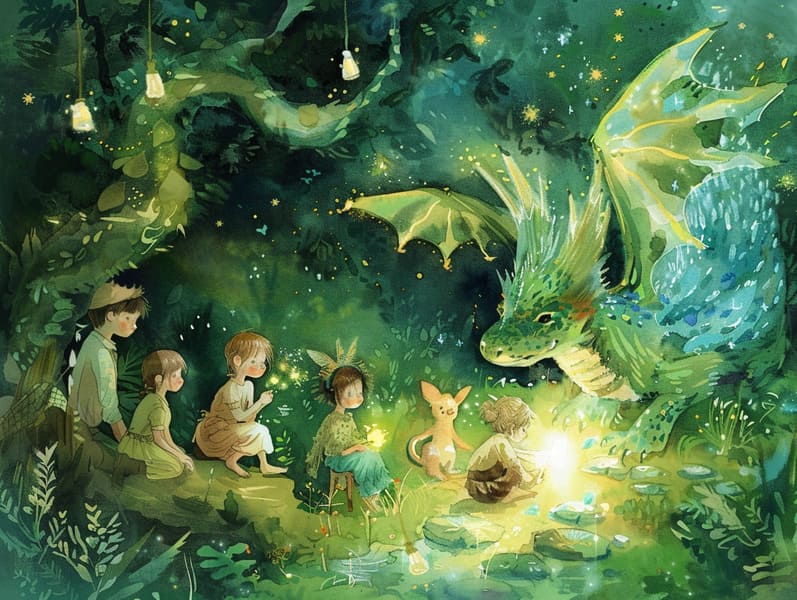
Popular fairy tales have timeless appeal. These tales have been spoken from one generation to the next far before they were ever recorded. They emerged from a variety of backgrounds, including Eastern traditions. They were initially transmitted among adults, often carrying themes and messages related to the societal norms and beliefs of the time.
The Brothers Grimm, the two Grimm brothers, were among the first to collect many of these beloved fairy tales. Their compilation, "Grimm's Fairy Stories," included narratives like "The Little Glass Slipper," "The Story of Hansel and Gretel," and "Little Snow White," which have since become staples in the world of children's fairy tales. Similarly, Hans Christian Andersen's imaginative narratives, such as "The Mermaid," and "The Little Duckling," have enchanted hearts worldwide, cementing their place in the pantheon of classic fairy tales.
Despite their age, traditional fairy tales remain as pertinent as ever, especially as bedtime stories for kids. These magical stories are now available in diverse formats, including colorful picture books, delightful animations, and internet fairy tales.
Their ongoing significance can be connected to several fascinating points:
Vital Lessons: Traditional fairy tales often impart important moral lessons. Tales like "The Wolf and the Liar" teach the benefit of sincerity, while "The Hare and the Tortoise" emphasize the virtues of steadfastness and humility. These narratives offer the young clear distinctions between correct and incorrect, helping to shape their moral compass in a mild yet important way.
Empathy and Understanding: Traditional fairy tales frequently depict figures facing challenges and struggles, urging young readers to understand with their struggles and back their triumphs. For instance, "Beauty and Her Beast" reveals the virtue of looking deeper to comprehend the true essence of a individual, strengthening warmth and recognition.
Cultural Awareness: Many old fairy tales are deeply ingrained in the cultural contexts from which they originated. Learning from these stories can provide captivating looks into different beliefs, strengthening a sense of global awareness and awareness.
Fantasy and Innovation: The mythical elements in fairy tales—talking animals—kindle children’s fantasies. These fairy tales bring readers to supernatural realms, unleashing creative thinking and a sense of magic that stays a lifetime.
Timeless fairy tales are not only whimsical but also educational. They serve as enchanted tools in building various cognitive and emotional skills in the young. When ancient fairy tales are recited, they enhance language development by teaching new language items and complex sentence structures. This practice also improves auditory perception and focus, as young ones track the narrative, anticipating to see what happens next.
Furthermore, exploring the themes and characters of ancient fairy tales can improve logical thinking and logical thinking. Children are instructed to find patterns, foresee events, and realize cause and effect. These debates also facilitate children speak out their thoughts and feelings, fostering their emotional intelligence.
In today’s high-tech era, the existence of web-based fairy tales has made these fairy tales more within reach than ever. Internet sites and digital apps give ample collections of bedtime fairy tales that can be looked at or listened to anytime, anywhere. Fairy tales spoken are particularly widespread, providing an interactive way for young readers to immerse in these alluring stories. Audio stories and read-out-loud stories take characters and settings to life, often augmented by entrancing soundtracks and instrumentals that intensify the tale experience.
The unending appeal of ancient fairy tales lies in their ability to change to the present while continuing with their core values. Contemporary renditions of these fairy tales often feature more varied protagonists and modern settings, making them familiar to today’s audience. However, the key lessons of spirit, goodness, and truth remain unchanged, continuing to affect readers of all ages.
Traditional fairy tales also offer a sense of familiarity and closeness. They highlight a well-structured narrative with a distinct beginning, middle, and end, often concluding with the settlement of conflicts and the triumph of justice over injustice. This constancy can be placating for young readers, proffering a sense of constancy in an ever-changing world.
Ancient fairy tales continue to charm and educate new generations, maintaining their grace and applicability in modern society. As kids' bedtime tales, they afford a perfect blend of fantasy and learning, promoting moral values, empathy, and creativity. The abundance of digital storybooks and the prevalence of fairy tales narrated assure that these old fairy tales remain obtainable to new generations.
By upholding and releasing these tales, we continue to praise the rich tapestry of legends and cultural heritage. Whether you are accessing a richly illustrated book, delving into a web-based collection, or listening here through an narrated book, the charm of timeless fairy tales is always within reach. These stories convey of the everlasting ability of narratives and its ability to unite us across eras and regions.
Regardless if you are enjoying a richly illustrated book, discovering a online collection, or hearing an audio story, the spell of children's fairy tales is always within reach.
These tales remind us of the unceasing strength of fairy tales and its ability to tie us across centuries and lands, casting a charm that charms and informs alike.